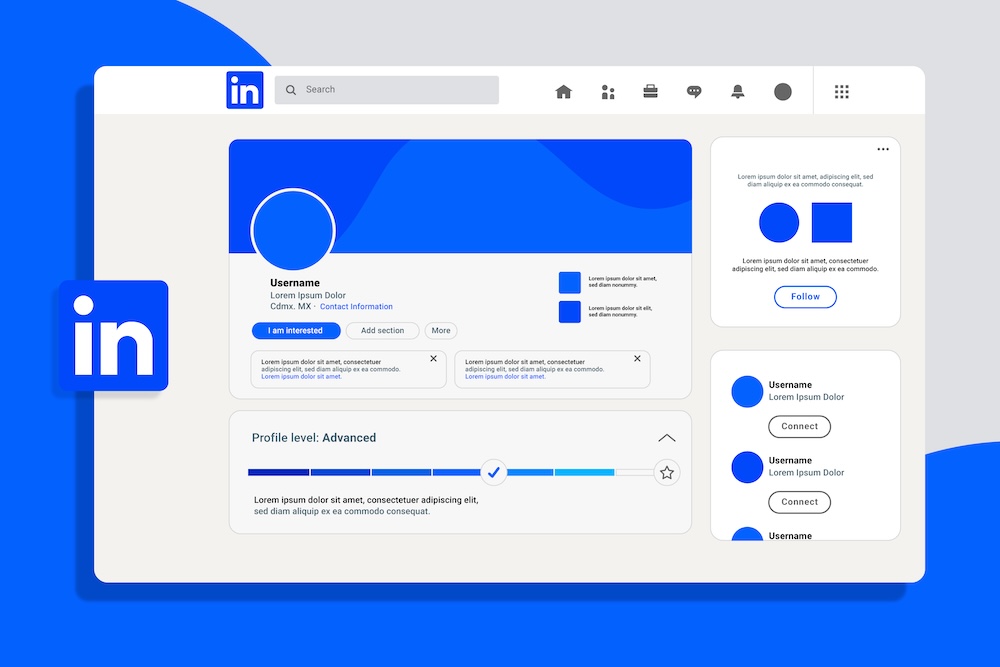
LinkedIn has transformed from a professional networking site into a powerhouse for sales prospecting. With over 900 million members worldwide, it offers unparalleled access to decision-makers, influencers, and potential clients across diverse industries. However, leveraging LinkedIn effectively for prospecting requires the right combination of tools and strategic steps.
In this guide, we’ll explore 5 essential tools and 8 actionable steps to enhance your LinkedIn prospecting efforts, helping you generate quality leads, drive business growth, and stand out from the crowd in the world’s biggest online business forum.
4 Tools for Effective LinkedIn Prospecting
1. LinkedIn Sales Navigator
You’ve probably already heard of it, and may even have used it extensively already. There’s a reason for that, as well: LinkedIn Sales Navigator is a premium tool tailored specifically for sales professionals, and is doubtless the most popular LinkedIn prospecting tool out there. It offers advanced features that go beyond the standard LinkedIn experience, making it indispensable for effective prospecting.
Why Use It?
Sales Navigator streamlines the prospecting process by providing deep insights and advanced search capabilities, enabling you to target and engage the right people more effectively.
2. Hunter.io
Hunter.io is an email-finding tool that allows you to discover and verify the email addresses of your prospects. Simply enter the name and company of a lead, and Hunter will provide the most likely email address associated with them, while also including verification technology that ensures the accuracy of those addresses, reducing bounce rates and improving deliverability.
Why Use It?
Hunter.io facilitates direct outreach beyond LinkedIn by providing verified contact information, enabling more personalized and effective communication with prospects.
3. Dux-Soup
Dux-Soup is a LinkedIn automation tool designed to streamline and automate various prospecting tasks, saving you time and effort. It’ll help you automatically visit LinkedIn profiles to increase your visibility and prompt reciprocal visits, while also making it possible to send automated, personalized connection requests to potential leads, enhancing your network efficiently.
Why Use It?
Dux-Soup automates repetitive tasks, allowing you to focus on building meaningful relationships and closing deals rather than managing tedious administrative work.
4. Crystal Knows
Crystal Knows is a unique tool that provides personality insights based on LinkedIn profiles, helping you tailor your communication style to each prospect. Understand the personality traits of your prospects, such as their communication preferences and decision-making styles, and receive recommendations on how to phrase your messages to resonate better with each individual’s personality.
Why Use It?
Crystal Knows empowers you to personalize your outreach, making your communications more effective and increasing the likelihood of positive responses.
8 Steps for Effective LinkedIn Prospecting
Step 1: Optimize Your LinkedIn Profile
Your LinkedIn profile serves as your digital business card —it can often be the first and last thing your potential connections will see, so you’d better make it count. A well-optimized profile is crucial for making a positive first impression on potential prospects. Here are a few quick tips on how to do exactly that.

Professional Photo
Use a high-quality, professional headshot that conveys trustworthiness and approachability. No car selfies, please — it’s not the early 2010s anymore. And don’t you dare forget to smile!
Compelling Headline
Craft a headline that clearly states your role and the value you offer. Avoid generic titles, focusing instead on how you can help your prospects achieve their goals.
Detailed Summary
Write a summary that highlights your expertise, achievements, and how you can solve your prospects’ pain points. For more immediate results, use keywords relevant to your industry to enhance visibility in LinkedIn’s standard search function.
Step 2: Identify Your Target Audience
Clearly defining your target audience is essential for effective prospecting. Knowing who you want to reach ensures that your efforts are focused and efficient, allowing you to spend more time and energy converting the relationships that matter, rather than wasting your resources on prospects that were never going to convert to begin with.

Define your Ideal Customer Profile (ICP)
Outline the characteristics of your ideal customers, including industry, company size, location, and job titles. Be as specific as possible — imagine these are real people, not abstract sets of characteristics.
Use Advanced Search
Utilize LinkedIn’s advanced search filters or Sales Navigator to find prospects that match your ICP. The more precise you can be at this stage, the better your chances of success.
Create Buyer Personas
Develop detailed buyer personas that include demographics, pain points, goals, and behaviors to guide your messaging and approach. Like with your ICPs, specificity is the name of the game here. Don’t be afraid to get super granular and discuss your ideas with your colleagues and team members if you feel that would be helpful.
Step 3: Build a High-Quality Network
A robust network enhances your visibility and credibility on LinkedIn, making it easier to connect with potential prospects. There’s nothing particularly valuable about a profile with only a dozen or so connections. On the other hand, if you’ve got a wide network full of thought leaders from a range of different industries, it clearly positions you as somebody worth listening to — and connecting with.

Connect Strategically
Send connection requests to individuals who fit your target audience, and always make sure to personalize your requests to increase acceptance rates. Don’t fall into the trap of spamming anybody and everybody you can think of. Be broad, but be selective.
Engage with Your Network
Regularly interact with your connections by liking, commenting, and sharing their content. This keeps you top-of-mind and fosters relationships. They might not turn into anything tangible immediately, but down the line, you just might find those people remember your name at the crucial moment.
Join Relevant Groups
Participate in LinkedIn groups related to your industry or target audience. Contribute valuable insights and engage in discussions to establish yourself as a thought leader. It’s vital that you don’t forget to maintain a professional, polite, empathetic persona throughout these interactions. Nothing looks worse for a potential business partner than a comment history full of abrasive, rude, or downright insulting statements.
Step 4: Create and Share Valuable Content
Content marketing on LinkedIn helps you attract and engage your target audience by providing value and demonstrating your expertise. There’s another potential benefit as well, beyond the first-order significance of your immediate connections finding your content useful. Everything you create that somebody thinks is worthwhile stands a good chance of being shared with their entire network, helping you dramatically increase the reach of all your posts without having to do any extra work yourself. Everybody wins!

Publish Articles
Write informative articles that address the pain points and interests of your prospects. Share actionable insights and practical solutions, tying them into real-world examples wherever possible. Don’t be worried if these don’t go viral right away — the best content strategists on LinkedIn know that consistency is the key to success.
Share Updates
Regularly post updates about industry news, company achievements, and relevant content to keep your network informed and engaged. Try not to be super cheesy here: everyone’s pretty tired of brands trying too hard. Short, sweet, and straight to the point is often the way to go.
Use Multimedia
Incorporate images, videos, and infographics to make your content more engaging and shareable. The more visually appealing you can make your posts, the better chance you’ll stand of catching somebody’s eye, so it’s always worthwhile to spend a bit of extra time making it all as beautiful as possible.
Step 5: Engage with Prospects
Active engagement is key to building relationships and moving prospects through the sales funnel. It can be easy to fall into the trap of thinking that everybody’s too fed up with prospecting online to bother with, but that’s not the case. At the end of the day, humans are humans, and we all like making meaningful connections. Don’t be too pushy, make sure to offer value before asking for anything, and you should be on the right track.

Personalized Messaging
When reaching out to prospects, personalize your messages based on their profiles and interests. If possible, remark on things they’ve shared in the past that you remembered as being particularly insightful. We all love a bit of flattery!
Comment Thoughtfully
Engage with your prospects’ posts by leaving thoughtful comments that add value to the conversation. This increases your visibility and demonstrates your expertise. Quality trumps quantity when it comes to comments. Nobody wants to work with an ardent spammer, but everybody wants insights from somebody who only comments when they know exactly what they want to say.
Respond Promptly
When prospects engage with your content or messages, respond promptly to keep the conversation flowing and show that you value their interaction. This isn’t just polite, it’s also a subtle way to demonstrate how you prioritize timeliness in a potential business relationship as well.
Step 6: Utilize LinkedIn’s InMail Effectively
InMail is a powerful feature that allows you to send messages to LinkedIn members you’re not connected with. Used correctly, it can significantly enhance your prospecting efforts. However, InMails are limited, so it’s vital you don’t waste any of those powerful little messages. Here are a few tips on making the most of your InMail opportunities.

Craft Compelling Subject Lines
Write attention-grabbing subject lines that encourage recipients to open your message. Keep them concise and relevant. You don’t want to be boring, but you don’t want to be clickbaity, either. Ideally, the subject matter itself should be compelling to the prospect, so it’s your job to present it in its best light, rather than misrepresent it altogether.
Personalize Your Messages
Tailor each InMail to the individual prospect. Reference their profile, company, or recent activity to show that you’ve done your homework, and you might just find that your open rates go through the roof with very little extra effort.
Provide Value
Focus on how you can help the prospect rather than pushing your product or service. Offer insights, solutions, or resources that address their specific needs, and do so without asking for anything in return. Once they come to think of you as an authority in your field, they often won’t hesitate to reach out for more comprehensive, long-term assistance.
Step 7: Leverage LinkedIn Analytics
Tracking and analyzing your LinkedIn activities helps you understand what’s working and where you need to improve. It’s like anything in sales — you need cold, hard information to make good decisions and promote long-term performance improvement. Fortunately, LinkedIn offers a few different ways for you to get granular with your data points.

Monitor Engagement Metrics
Keep an eye on metrics such as likes, comments, shares, and views to gauge the effectiveness of your content and engagement strategies. Change things up if they’re not working and double down when you strike content gold. Over time, you’ll be amazed at the results you’ll end up with.
Track Connection Growth
Analyze your network growth over time to ensure you’re consistently expanding your reach within your target audience. If you’re stalling, take a few days to try and interrogate why. Maybe your content has gotten stale, or you’ve been reaching out to the wrong people. Whatever it is, it’s happening for a reason, so don’t just dive headfirst into what wasn’t working without trying to figure out the root causes behind the issue.
Conclusion
Effective LinkedIn prospecting requires a strategic approach combined with the right tools and consistent execution. By leveraging LinkedIn Sales Navigator, Hunter.io, Dux-Soup and Crystal Knows, you can enhance your ability to identify, engage, and convert high-quality leads.
Couple those tools with the 7 actionable steps we’ve gone over above — optimizing your profile, identifying your target audience, building a high-quality network, creating valuable content, engaging with prospects, utilizing InMail effectively, and leveraging analytics — and you’ll be perfectly positioned to maximize your LinkedIn prospecting efforts.
FAQ
Use a professional photo, a clear headline, and a detailed summary that highlights your value and expertise for potential prospects.
Optimize your profile, identify your target audience, build a strong network, engage with prospects, and use LinkedIn analytics to improve your efforts.
LinkedIn provides access to a vast network of professionals, allowing salespeople to connect directly with decision-makers and influencers in their target industries.


